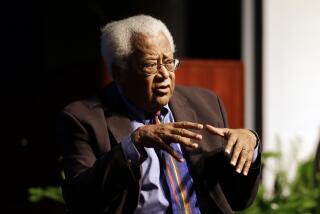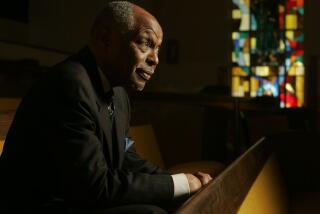Clancy Imislund, longtime director of L.A.’s Midnight Mission, dies at 93
Restoring his faith in a higher power was the hardest step for Clancy Imislund.
So when the day finally came in October 1958, to take that step, he put his faith in Bob.
“I’ll try to do what Bob says,” he recounted decades later.
That wasn’t Dr. Bob, co-founder of Alcoholics Anonymous, but just Bob, a run-of-the-mill actor who became his sponsor in the latest of many episodes of sobriety. After several weeks of tagging along with Bob to grab food at AA meetings, Imislund had an awakening.
“I began to get the sense that Bob knew how I felt,” he said, a sense he had never gotten before from father, friend or therapist.
“I never knew anybody who knew how I felt,” he said. “People like us are magnets for advice from everybody that we know. But if you can find someone you believe knows how you feel, that advice becomes meaningful information.”
Imislund stayed sober that time, and for the next 62 years he carried the message around the world, giving talks almost weekly at AA meetings from South Dakota to Reykjavik, Iceland, and becoming a sponsor to thousands of others.
Along the way, he left a lucrative career with a Beverly Hills marketing firm to become managing director of the Midnight Mission in downtown’s skid row, returning as a transformative leader to an institution that had once kicked him out for bad behavior. Under his hand, the soup kitchen and housing facilities grew with programs to address the social needs of skid row, said its president and CEO G. Michael Arnold.
“He’s probably the first person to bring substance use treatment to people living on skid row,” Arnold said.
Evolving from executive to ambassador at-large, Imislund held the title of managing director for the next 46 years until his death Monday at 93.
He left a legacy in the quasi-secret world of AA unmatched by any but founders Bill Wilson and Dr. Bob, said Stephen Watson, a Midnight Mission board member and one of the roughly 170 people Imislund was sponsoring up to his death.
Imislund died of an undetermined cause while in isolation following a positive test for COVID-19, his daughter Mary Imislund Dougherty said. He was undergoing rehabilitation for a broken hip and was at the end of the isolation period when the rehabilitation center informed her of his death, she said.
Growing up in a Norwegian Lutheran family in Eau Claire, Wis., Imislund discovered, as he would later confess, that, “I seem to need more fun than other Lutherans somehow.”
By the time he was 15, straight A’s and self-discipline were behind him.
“I have a flair for doing the wrong thing, to almost instantly do the worst thing I could have done,” he said.
The attack on Pearl Harbor offered an escape. He hitch-hiked to San Francisco intending to make something of himself as a war hero. Stints in the merchant marine, then the Navy introduced him to whiskey and tobacco to the betterment of his self-image if not his character.
“I felt like men looked,” he said of his emotional reaction to alcohol.
After the war Imislund returned to Wisconsin, enrolled in college, married Charlotte, “this girl with flashing black eyes and black hair,” and settled into what he would later recognize to be the normal life of an alcoholic.
Nights with family punctuated by nights in jail culminated in a vow of sobriety, made over the coffin of his first son, who died on a frigid winter night when Imislund was jailed and didn’t make it home to restart a finicky heater.
“John Imislund, this will never happen again.” It was a vow made to be broken.
The family moved a lot. The time in El Paso stands out as the pleasantest of her life, his daughter said.
Her father, a talented self-taught musician, partied at home with the city’s marijuana-smoking jazz musicians.
“My happiest memories are laying in my bed, smelling that smell, hearing that music,” she said. “They would sit all night and play the most amazing incredible music. He just gathers these incredible people.”
In Texas, Imislund had great jobs, Mary said, among them even directing the Grand Opera at the University of Texas. But he always lost them, falling victim to what he would describe as the recurring “spring in my gut” that made him restless, eventually turning the world from “technicolor to black and white.”
A nearly successful suicide attempt led to a mental commitment and electric shock therapy.
Thorazine and tequila followed. The night he went out to buy food for his new daughter Susan and didn’t come back, Charlotte packed up the kids and resettled in a one-bedroom apartment.
Imislund eventually headed for Los Angeles.
After being ejected from the Midnight Mission, Imislund made the most important trip of his life, walking miles to the AA club at Wilshire and Fairfax where he fell under Bob’s sway.
“He found me ways not to quit jobs,” Imislund would say. “A terrible process. I finally held a job for four months before I got fired.”
Gradually, Bob broke through to Imislund’s faith which had been devastated by the belief that God took his son’s life to pay for his sins.
“Kid, you’re not important enough for God to hate,” Bob told him. “By the time he died, I believed in AA as the higher power,” Imislund would say.
It took five years to regain Charlotte’s trust. He got a job in advertising, became head of a family again and founded the Pacific Group, held in a Westside synagogue, that has grown into one of the world’s longest standing and largest AA meetings, said Watson, the Midnight Mission board member.
Within AA, Pacific Group has its detractors who find it cultish and doctrinally severe.
“I don’t like the Pacific and avoid them,” said Sarah D. of Dallas in an email to The Times. But not Imislund.
“Clancy inspired the masses,” she wrote. “I see in my mind’s eye ... so many rooms, so many people crowded into the back, outside, in adjoining rooms. I remember his words. I hear the laughter. And i am grateful.”
He became what Watson would describe a 12-step “rock star,” becoming sponsor to Hollywood elites, judges and business executives along with the people he picked up off the street.
“If you asked Clancy how many people he had sponsored he would say, ‘One too few,’ ” Watson said. He estimates the number at 10,000 with the ripple effect touching tens of thousands of lives.
Family ties with his four daughters and surviving son were stable but distant, Susan Imislund Yodice, the daughter born in Texas, said. The daughters understood his absences as necessary amends for “things you can never undo.” After Charlotte died in 2012, their father became more spiritual and a more attentive father.
“He became this accessible, very loving dad,” she said. “I feel grateful that in my 50s I got this dad. And that’s been a joy.”
It was in 1974 that Imislund returned to the Midnight Mission. Under his leadership its mission expanded to embrace treatment, work and housing services. He built its financial base with his pen, president and CEO Arnold said.
“He would open the phone book and start writing letters to people in the phone directory,” Arnold said.
“He could create some of the most compelling stories about both recovery and the work of the Midnight Mission,” Arnold said. “It’s hard to separate Clancy from either the Midnight Mission or the AA. He dedicated the last 46 years of his life to trying to do good with those two messages.”
In his talks, Imislund spoke of AA as a mystery with a practical goal.
“Nobody knows why it works,” he said. “The purpose of AA is not to make you dry longer and longer. The purpose of AA is to do very slowly what alcohol did fast. To change my perception of reality.”
More to Read
Start your day right
Sign up for Essential California for the L.A. Times biggest news, features and recommendations in your inbox six days a week.
You may occasionally receive promotional content from the Los Angeles Times.







